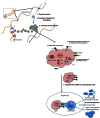Mechanisms of action of adjuvants
- PMID: 23720661
- PMCID: PMC3655441
- DOI: 10.3389/fimmu.2013.00114
Mechanisms of action of adjuvants
Abstract
Adjuvants are used in many vaccines, but their mechanisms of action are not fully understood. Studies from the past decade on adjuvant mechanisms are slowly revealing the secrets of adjuvant activity. In this review, we have summarized the recent progress in our understanding of the mechanisms of action of adjuvants. Adjuvants may act by a combination of various mechanisms including formation of depot, induction of cytokines and chemokines, recruitment of immune cells, enhancement of antigen uptake and presentation, and promoting antigen transport to draining lymph nodes. It appears that adjuvants activate innate immune responses to create a local immuno-competent environment at the injection site. Depending on the type of innate responses activated, adjuvants can alter the quality and quantity of adaptive immune responses. Understanding the mechanisms of action of adjuvants will provide critical information on how innate immunity influences the development of adaptive immunity, help in rational design of vaccines against various diseases, and can inform on adjuvant safety.
Keywords: adjuvants; antigen presentation; cell recruitment and activation; dendritic cells; inflammasomes; innate immunity; mechanisms.
Figures

References
-
- Brewer J. M., Pollock K. G. J., Tetley L., Russell D. G. (2004). Vesicle size influences the trafficking, processing, and presentation of antigens in lipid vesicles. J. Immunol. 173, 6143–6150 - PubMed
LinkOut - more resources
Full Text Sources
Other Literature Sources
Miscellaneous

